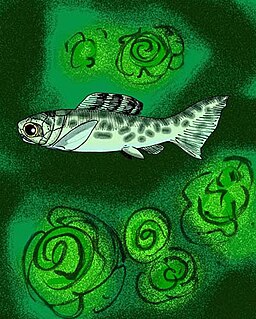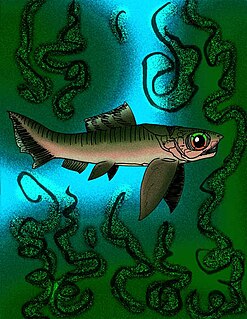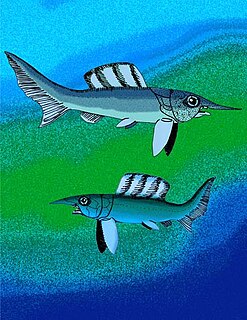
Placodermi is a class of armoured prehistoric fish, known from fossils, which lived from the Silurian to the end of the Devonian period. Their head and thorax were covered by articulated armoured plates and the rest of the body was scaled or naked, depending on the species. Placoderms were among the first jawed fish; their jaws likely evolved from the first of their gill arches.

Dunkleosteus is an extinct genus of large armored, jawed fishes that existed during the Late Devonian period, about 382–358 million years ago. It consists of ten species, some of which are among the largest placoderms to have ever lived: D. terrelli, D. belgicus, D. denisoni, D. marsaisi, D. magnificus, D. missouriensis, D. newberryi, D. amblyodoratus, and D. raveri. The largest and most well known species is D. terrelli, which grew up to 8.79 m (28.8 ft) long and 4 t in weight. Dunkleosteus could quickly open and close its jaw, like modern-day suction feeders, and had a bite force of 6,000 N at the tip and 7,400 N at the blade edge. Numerous fossils of the various species have been found in North America, Poland, Belgium, and Morocco.

Rolfosteus is an extinct monospecific genus of arthrodire placoderm from the Early Frasnian stage of the Late Devonian period, found at the Gogo Formation of Western Australia.

Selenosteidae is an extinct family of small to large-sized arthrodire placoderms from the Late Devonian. With the exception of the Chinese Phymosteus, selenosteids lived in shallow seas in what is now Eastern North America, Eastern Europe, and Northeastern Africa.

Draconichthys elegans a selenosteid arthrodire placoderm from the Late Frasnian Kellwasserkalk facies of the Anti-Atlas Mountains of what is now Morocco. During the Late Devonian, the region would have been a shallow, algae-dimmed sea.

Hadrosteus is an extinct monospecific genus of large arthrodire placoderm from the Late Frasnian Kellwasserkalk facies of Bad Wildungen, Germany. It had large, double-pronged inferognathals, and serrated edges along its mandible, strongly suggesting that it was a fish-eating predator. The head had a triangular snout, and the trunkshield was short, but high, with a median dorsal plate that was broader than wide. The average skull length is about 16 centimeters.

Stenosteus is an extinct monospecific genus of medium-sized selenosteid arthrodire placoderms of the Late Devonian period known from the Upper Famennian Cleveland Shale of Ohio. Estimated skull lengths range from 6 to 9 centimeters Most fossils of Stenosteus have been scraps of armor and portions of tooth-plates suggestive of Selenosteus. In 1996, enough material of a new species, S. angustopectus, was recovered to allow a reconstruction of armor that resembles that of Selenosteus.

Microsteus is an extinct genus of small selenosteid arthrodire placoderms known from the Upper Frasnian Kellwasserkalk facies of Late Devonian Germany.

Enseosteus is an extinct genus of small selenosteid arthrodire placoderms known from the Upper Frasnian Kellwasserkalk facies of Late Devonian Germany and Morocco.
Erromenosteus is a genus of extinct, medium-sized brachythoracid arthrodire placoderm from the Late Frasnian of the Kellwasserkalk facies of Late Devonian Bad Wildungen and Bicken, Germany.

Melanosteus is an extinct genus of small selenosteid arthrodire placoderms of the Late Devonian period known from the Upper Frasnian Montagne Noire of Southern France. Rücklin (2011) regards Melanosteus as the sister taxon of Rhinosteus. During the Frasnian stage, Melanosteus occitanus lived off the coast of an island continent, "Armorica," which consisted of portions of what would become Southern France.

Braunosteus schmidti is a medium-sized selenosteid arthrodire placoderm known from the Upper Frasnian Kellwasserkalk facies of Late Devonian Bad Wildungen, Germany. B. schmidti has a broad skull about 9 centimeters long, and a short, but pointed rostrum. Its appearance is very similar to that of the basal selenosteid Pachyosteus.

Pachyosteus is an extinct monospecific genus of medium-sized selenosteid arthrodire placoderm known from the Upper Frasnian Kellwasserkalk facies of Late Devonian Bad Wildungen, Germany and from the Famennian portions of the Holy Cross Mountains of Poland. The type species Pachyosteus bulla has a broad skull about 7 to 10 centimetres long, a comparatively long median dorsal plate, and a short rostral plate that meets the pineal plate.

Walterosteus is an extinct genus of small selenosteid arthrodire placoderms known from the Upper Frasnian Kellwasserkalk facies of Late Devonian Germany and Morocco.

Brachydeiridae is a family of small to moderately large-sized arthrodire placoderms from the Late Devonian of Europe, restricted primarily to the Kellwasserkalk Fauna of Bad Wildungen and Adorf.

Brachydeirus is a genus of small to moderately large-sized arthrodire placoderms from the Late Devonian of Europe, restricted to the Kellwasserkalk Fauna of Bad Wildungen and Adorf.

Oxyosteus is a genus of trout-sized, highly compressed arthrodire placoderms from the Late Devonian of Europe: The two described species are restricted to the Late Frasnian-aged Kellwasserkalk Fauna of Bad Wildungen, while a median dorsal plate of an unnamed species is known from the Middle Frasnian Holy Cross Mountains of Poland.

Trematosteus is an extinct monospecific genus of arthrodire placoderm from the Late Frasnian stage of the Late Devonian period. Fossils are found from Bad Wildungen, Germany.
Tapinosteus is an extinct monospecific genus of arthrodire placoderm from the Late Frasnian stage of the Late Devonian period. Fossils are found from Bad Wildungen, Germany.
Brachyosteus is an extinct genus of arthrodire placoderm from the Late Frasnian stage of the Late Devonian period. Fossils are found from Bad Wildungen, Germany.
























